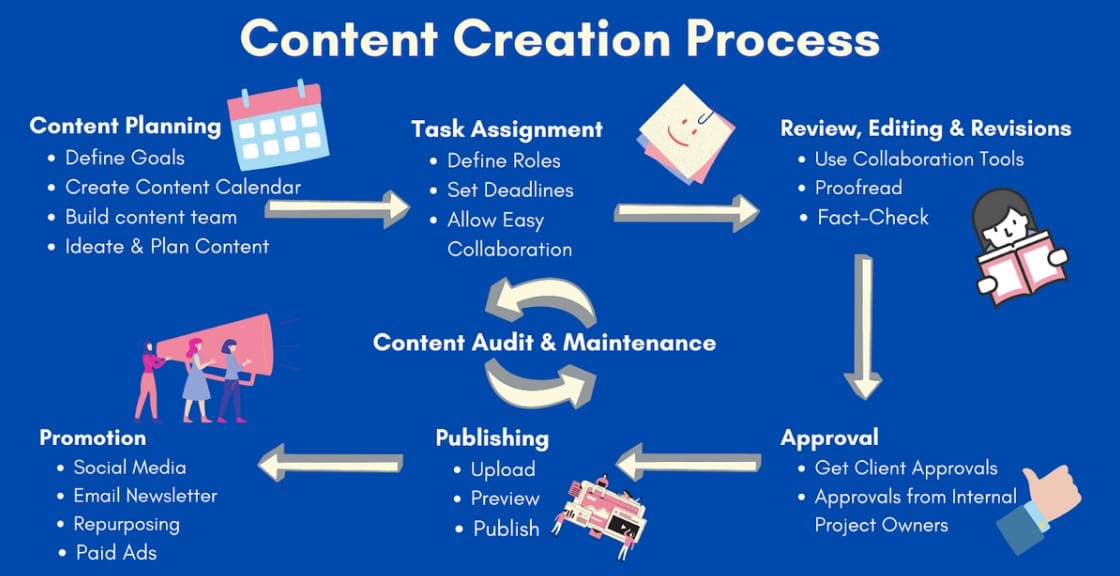From Chaos to Harmony: Managing Large Content Teams
Managing large content teams can quickly lead to chaos missed deadlines, poor communication, and inconsistent quality. EasyContent centralizes workflows, clarifies roles, and simplifies approvals, helping teams collaborate effectively, meet deadlines, and produce better content faster.

Managing a sizable content team is like running an orchestra—every writer, editor, and strategist must be in harmony for everything to go naturally. Things may rapidly slide into anarchy without clear coordination, resulting in missed deadlines, uneven material, and needless traffic jams. Multiple individuals working on content creation makes it simple for chores to go through the gaps, feedback to be missed, and initiatives spanning longer than they should be pursued.
Maintaining everyone in line presents one of the toughest tasks content managers have.While team leads need a means of following development without continually searching updates, editors want ordered review procedures and authors need clarity on duties. Large teams may have miscommunication; without the right processes in place, things can go wrong.
Therefore, a solid content management system is not only necessary to maintain organization of material but also guarantees that everyone understands their roles and obligations.While many teams rely on Google Docs and remote technologies, these solutions lack built-in approval mechanisms or structured processes, which leads to dispersed cooperation even if many teams depend on them.
Now along comes EasyContent, a technology designed expressly to boost output in content teams. Unlike traditional document-sharing systems, EasyContent centralizes procedures, approvals, and assignments in one place thereby ensuring that everyone stays on the same page. Working collaboratively, writers, editors, and stakeholders can monitor development, cut out the constant back-and-error slowing down content production, and provide easy access between them.
From simplifying processes and defining clear responsibilities to using the correct technologies for optimal efficiency, this article will investigate doable tactics for writers and editors to properly manage sizable content teams. Whether you operate an in-house editorial team, content marketing firm, or large-scale content initiative, these ideas will help you increase output, raise content quality, and provide a smooth process that really works.
Efficiency rules everything in the realm of content generation. Let's explore the finest strategies to maintain big teams functioning at their best, on time, and in unison.
Challenges of Managing Large Content Teams
Oversaw a sizable content crew was no simple chore. Keeping things orderly and making sure material meets deadlines might seem daunting given several writers, editors, and interested stakeholders. Without the correct procedures in place, anarchy rules—content disappears, feedback loops become disorganizing, and quality suffers.
Teams managing large volume content creation must find and solve typical problems before they reduce effectiveness. These are some of the main obstacles content managers deal with; EasyContent can help to simplify the process.
1. Scattered Workflows: Content Chaos Without Structure
One of the biggest headaches in managing large teams is disorganized workflows. Writers work on their drafts, editors make revisions, and stakeholders give feedback but if there's no centralized process, things get messy, fast.
Content pieces sit in different folders, shared drives, and email threads.Team members don’t know who’s working on what at any given time.Projects fall through the cracks because there’s no clear tracking system.
🔹 How EasyContent Helps: EasyContent brings everything into one place. Writers, editors, and reviewers can track progress in a structured workflow, eliminating confusion and keeping content moving smoothly.
2. Inconsistent Quality: Struggles with Brand Voice & Style
When multiple people are writing and editing content, inconsistencies are bound to happen. Different writing styles, editing approaches, and a lack of clear brand guidelines can make content feel disjointed.
Some pieces sound formal, while others are too casual. Writers may miss key messaging or brand tone due to lack of reference materials. Editors struggle to enforce uniform standards across multiple projects.
🔹 How EasyContent Helps: EasyContent allows teams to create structured content templates and style guides within the platform, ensuring every piece of content follows a consistent format, tone, and messaging style.
3. Missed Deadlines: The Approval Process Bottleneck
Content deadlines are crucial, but without clear accountability, things get delayed. Writers may take longer than expected, editors may have too many revisions, or final approvals may sit unattended for days.
Writers don’t always know when their drafts are due. Editors spend too much time waiting for revisions instead of working on new content. Approvals get stuck in an endless cycle because no one knows who has the final say.
🔹 How EasyContent Helps: EasyContent automates the approval process, ensuring that tasks are assigned, deadlines are met, and notifications remind team members when it's their turn to take action. No more chasing approvals - everything moves forward effortlessly.
4. Feedback Overload: Too Many Revisions, Too Much Confusion
Ever had a draft go through 10 rounds of feedback just to end up looking like the first version? Without a structured feedback process, teams can fall into a cycle of endless revisions, wasting valuable time.
Editors and stakeholders leave conflicting feedback on different versions. Writers struggle to implement changes when feedback is scattered across emails and comments. No clear system to track which suggestions have been implemented.
🔹 How EasyContent Helps: EasyContent organizes feedback within the approval workflow, ensuring that revisions are tracked properly and feedback is clear, consolidated, and easy to follow.

Establishing a Clear Workflow for Writers and Editors
Working with a big content team, organization is everything. Without a defined methodology, content development may rapidly turn chaotic—deadlines are missed, input is scattered, and quality suffers. Managers require insight into development; editors need a methodical approach for reviews; writers need clear standards on what is expected.
Establishing a well defined procedure is therefore absolutely vital. It guarantees consistency, efficiency, and flawless teamwork in addition to helping content teams keep on target. Here's how you may create a seamless content flow for editors and authors, thereby organizing and increasing the whole process's output.
1. Define the Content Creation Process
Before diving into content production, your team needs a clear roadmap. Content creation involves multiple steps, and if they aren’t well-defined, things can fall apart quickly.
A structured content workflow should include:
- Ideation – Brainstorming topics and aligning them with content goals.
- Assignment – Assigning writers and setting deadlines.
- Drafting – Writers create the first draft based on brand guidelines.
- Editing & Revisions – Editors refine the content for clarity and accuracy.
- Approval Process – Stakeholders review and finalize the piece.
- Publishing & Distribution – The content goes live and is promoted.
🔹 How EasyContent Helps: With EasyContent, you can define each step of the content process, ensuring that everyone knows their role and what comes next. Instead of managing content through scattered tools, everything happens in a single, structured workflow.
2. Use a Centralized Content Management System
One of the biggest challenges in large teams is keeping track of multiple content pieces, feedback, and approvals. When files are spread across different folders, email threads, and Google Docs, things can get messy fast.
To prevent this, teams need a centralized content management system where:
- All drafts, approvals, and feedback are stored in one place.
- Writers, editors, and managers can collaborate in real-time.
- The entire content pipeline is visible, eliminating confusion.
🔹 How EasyContent Helps: EasyContent acts as a content hub where all tasks, drafts, and approvals are stored. Instead of jumping between emails, spreadsheets, and documents, teams can work inside one unified platform, making collaboration more efficient and stress-free.
3. Set Deadlines and Milestones
Without clear deadlines, content production can easily fall behind. Teams need well-defined timelines to ensure content moves smoothly through each stage.
To stay on track:
- Set realistic deadlines for each phase (drafting, editing, approvals).
- Use content calendars to plan ahead and avoid last-minute chaos.
- Assign clear responsibilities so writers and editors know their tasks.
- Monitor progress and make adjustments if necessary.
🔹 How EasyContent Helps: With built-in deadlines, task assignments, and automated reminders, EasyContent ensures that no piece of content falls through the cracks. It keeps the entire team aligned, ensuring that content is delivered on time, every time.
Assigning Roles and Responsibilities in a Large Content Team
Like a well-oiled machine, a well-organized content team is dependent on each individual to guarantee seamless production, quality materials, and strategic alignment. But without well defined roles and duties, things may get chaotic. Tasks overlap, approvals get delayed, and accountability becomes an issue.
To keep everything organized, it’s important to assign clear responsibilities to each team member. Here’s how a content team should be structured and how EasyContent can help ensure seamless collaboration and workflow efficiency.
1. Writers: The Foundation of Content Creation
Every content team consists mostly of writers. Their roles are in research, development, and creation of interesting material fit for brand message. Without well defined rules, nevertheless, drafts may turn out uneven in tone, style, or message, adding extra work for editors.
🔹 Key Responsibilities of Writers:
- Research and compile reliable material for your content.
- Write in neat, intriguing, and short bursts.
- Maintain constant brand tone and voice.
- As needed, use editor comments to direct changes.
🔹 How EasyContent Helps:
With EasyContent, writers receive structured briefs, clear deadlines, and assigned tasks all in one place. No more confusion about what needs to be done or where to submit drafts - it’s all streamlined within the platform.
2. Editors: The Gatekeepers of Quality
Ensuring that material is polished, error-free, and consistent with the brand message falls on editors. Before they get to the approval level, they polish manuscripts so they are grammatically sound, well-structured, and interesting.
🔹 Key Responsibilities of Editors:
- Proofread and edit content for grammar, clarity, and readability.
- Ensure content follows brand guidelines and maintains a consistent tone.
- Provide constructive feedback to writers for revisions.
- Collaborate with content strategists to refine messaging.
🔹 How EasyContent Helps:
EasyContent makes the editing process seamless by allowing editors to review drafts, leave feedback, and approve changes, all within a structured workflow. No need to chase writers for revisions or deal with scattered comments across different tools.
3. Project Managers: Keeping Content on Track
A content project can have multiple moving parts, and without strong project management, things can quickly go off track. Project managers play a crucial role in overseeing workflow, ensuring deadlines are met, and keeping the team aligned.
🔹 Key Responsibilities of Project Managers:
✔ Oversee content timelines and deadlines to ensure smooth progress.
✔ Assign tasks and ensure writers, editors, and stakeholders know their roles.
✔ Monitor bottlenecks in the workflow and implement solutions.
✔ Communicate with different departments to keep projects aligned.
🔹 How EasyContent Helps:
With EasyContent’s built-in task management and workflow tracking, project managers can see real-time progress, assign roles, and ensure nothing falls behind schedule. No more manual follow-ups or confusion about content status.
4. Content Strategists: Aligning Content with Business Goals
Content isn’t just about writing it’s about driving results. Content strategists ensure that every piece of content aligns with marketing goals, SEO strategies, and audience needs.
🔹 Key Responsibilities of Content Strategists:
- Develop content plans and editorial calendars.
- Optimize content for SEO, engagement, and conversions.
- Ensure topics align with business and marketing objectives.
- Monitor performance metrics and suggest improvements.
🔹 How EasyContent Helps:
EasyContent allows strategists to organize content plans, track performance, and collaborate with writers and editors. By keeping everything structured, they can maintain a strategic approach to content creation.
Leveraging Technology for Better Team Coordination
Oversaw a content team could feel like juggling twelve items at once. Without a good structure in place, things may rapidly spiral into anarchy between job assignment, tracking progress, handling approvals, and guaranteeing deadlines are reached. That’s where technology steps in as a game-changer, helping teams work more efficiently, streamline collaboration, and reduce unnecessary manual work.
By leveraging the right tools, content teams can eliminate bottlenecks, improve communication, and boost overall productivity. Here’s how to use technology to improve team coordination, with EasyContent playing a key role in simplifying workflows.
1. Use Task Management Tools to Keep Everyone Aligned
Tracking assignments and permissions is one of the toughest issues in running sizable content teams. Without a good structure, chores could fall through the gaps and cause last-minute hurries and missing deadlines.
Task management tools, like EasyContent, solve this problem by:
- Assigning roles and responsibilities (writers, editors, reviewers) so everyone knows what they need to do.
- Tracking approvals and revisions in real time to avoid back-and-forth confusion.
- Providing a clear workflow, so content moves from draft to publication without unnecessary delays.
With EasyContent, you can see exactly who’s working on what, what’s pending approval, and what’s ready to publish all from one centralized dashboard. No more lost documents or scattered email chains!
2. Automate Repetitive Tasks to Save Time
Let’s be honest - no one likes manually following up on approvals, sending reminders, or tracking down missing drafts. It’s time-consuming, frustrating, and takes time away from more important work like content strategy and optimization.
That’s where automation comes in. With the right tools, you can:
- Set up automated reminders for pending approvals, so no one forgets their tasks.
- Schedule content deadlines to ensure projects stay on track.
- Eliminate unnecessary follow-ups by notifying team members when action is required.
With EasyContent, these repetitive tasks become effortless. The platform automatically notifies stakeholders when their input is needed, ensuring that content keeps moving forward without unnecessary delays.
3. Enable Real-Time Collaboration for Seamless Communication
Miscommunication is one of the biggest productivity killers in content teams. When feedback is spread across emails, Slack messages, and comments in different tools, it becomes difficult to track changes and implement suggestions efficiently.
By using real-time collaboration tools, teams can:
- Edit content together simultaneously, reducing long review cycles.
- Leave feedback in an organized way, so revisions are clear and actionable.
- Ensure that everyone is working on the latest version, avoiding version-control issues.
EasyContent makes collaboration seamless by allowing real-time edits, structured feedback, and task tracking - all within one platform. Writers, editors, and project managers can work together without switching between multiple tools, making content production faster and smoother.

Maintaining Consistency in Content Quality
In the busy field of content production, consistency is absolutely vital. Whether you are writing blog posts, social media content, or website text, your readers want a consistent tone, style, and degree of quality. When numerous writers, editors, and stakeholders are involved, maintaining everything in line might be somewhat challenging, though.
Every piece of material guaranteed by a well-run operation satisfies brand rules, interacts with the audience, and preserves professionalism standards. This is how to sustain constant content quality apart from team size.
1. Develop a Content Style Guide
One of the biggest reasons content feels inconsistent is the lack of a clear style guide. Without one, writers may use different tones, formats, or even punctuation styles, making content feel disjointed.
A content style guide acts as a rulebook for writers and editors, ensuring that:
- The brand’s tone and voice stay uniform across all content.
- Standardized formatting guidelines include headers, lists, and font options.
- Preferred spelling and grammar rules apply (e.g., "e-commerce" vs. "eCommerce").
🔹 By use of the EasyContent platform, teams may preserve and share style guides, therefore ensuring that every writer and editor follows the same set of rules. Not one more inconsistent formatting error or tone!
2. Create Reusable Templates for Faster, More Consistent Content
If your team produces a lot of material, starting from scratch each time is inefficient and risky; one writer may arrange an article differently than another, causing flow and readability problems.
Using pre-built content templates ensures that:
- Content is easily readable because of its organized style; moreover, writers avoid missing crucial parts as CTAs, introductions, or main ideas.
- Editors know what to anticipate, hence the approval process moves more quickly.
🔹 Because EasyContent enables teams create and preserve content templates, every blog post, landing page, or social media caption follows a predetermined format. This accelerates, streamlines, and more precisely follows content creation to brand specifications.
3. Implement a Multi-Step Editing Process
Even the greatest editors sometimes overlook minute details and even the finest authors make blunders. That’s why having a structured editing process is essential for maintaining quality.
A multi-step editing process includes:
- Peer Reviews: Before it gets to an editor, another writer examines the draft.
- Editors make sure language, clarity, and brand standard adherence is clear-cut.
- Stakeholders or project managers provide the last green signal.
🔹 Easy Content helps by automating the review process, therefore guaranteeing that every piece of material passes via a controlled approval system. Direct comments left by editors and reviewers straight on the platform will help to avoid many email chains and uncertainty.
Encouraging Open Communication and Feedback
A content team that is in good working order is about clear communication and efficient feedback rather than only outstanding writing and editing. Projects are delayed, feedback loops get annoying, and misunderstandings mount up when teams fail to get along. Conversely, when managers, editors, and authors may freely work together, content creation runs naturally and advances with time.
Encouragement of honest communication and organized feedback guarantees that everyone is in agreement, that expectations are clear, and that changes do not seem as though they are an endless loop. Here's how your content team may build openness and teamwork.
1. Hold Regular Check-Ins to Keep Teams Aligned
When content teams work in silos, misalignment creeps in writers might not understand what’s expected, editors may struggle with inconsistent drafts, and deadlines might get missed. Holding regular check-ins can solve these issues before they become bigger problems.
- Weekly or bi-weekly meetings help address content priorities, upcoming projects, and roadblocks.
- Writers and editors can discuss challenges before they cause delays.
- Managers can provide clarity on expectations and deadlines.
🔹 How EasyContent Helps: Instead of waiting for the next meeting, teams can use EasyContent’s shared dashboard to track progress, see pending approvals, and communicate in real time all without needing lengthy meetings.
2. Encourage Constructive Feedback Without Frustration
Let’s be real—feedback can sometimes feel overwhelming or unclear, especially when it’s scattered across emails, comments, and Slack messages. But without feedback, content quality suffers.
To ensure feedback helps rather than hinders progress:
- Create a structured review process where writers know exactly when and how they’ll receive feedback.
- Encourage constructive, solution-oriented feedback - instead of just pointing out issues, suggest how to fix them.
- Normalize two-way feedback, writers should also feel comfortable asking editors for clarity on revisions.
🔹 How EasyContent Helps: EasyContent allows editors to leave feedback directly within the content workflow, keeping all suggestions organized and actionable. No more endless email chains or vague revision requests!
3. Use Clear Communication Channels to Avoid Clutter
One of the biggest collaboration killers? Long, scattered email threads where important information gets buried. A content team needs centralized communication where:
- Writers, editors, and stakeholders communicate in one place.
- Feedback and revisions are tracked in a structured way.
- Everyone has real-time visibility into content status.
🔹 How EasyContent Helps: With built-in comment sections and real-time collaboration features, EasyContent eliminates the need for external messaging tools. Instead of switching between email, Slack, and Google Docs, teams can handle everything inside one platform.

Scaling Your Content Team Efficiently
Demand for excellent content rises together with the size of your company. Larger content teams entail more moving components, more approvals, and more chances for things to become messy whether you're writing blog entries, whitepapers, or marketing material. Scaling without a method can cause delays, uneven quality, and poor communication among other things.
So, how can you grow your content team without lowering the quality or speed of work? You will get a lot out of improving your processes, making hiring easier, and writing down routines all the time. This shows the right way.
1. Onboard New Writers and Editors Effectively
Things can move more slowly when you add new writers and editors to the team without a set plan for how to train them. Instead of giving them tasks to do on their own, make sure they:
- Read examples of past work to get a sense of the tone, style, and standards.
- Learn the basics - how to write, format, and use SEO the right way.
- Make sure everyone knows exactly what their job is by giving them clear tasks.
🔹 How EasyContent helps: New team members can quickly find style guides, content templates, and all the important steps in one place. That means less confusion, faster onboarding, and more consistent content.
2. Keep Workflows and Best Practices Organized
Your team needs a clear way of working, no matter where their content comes from - books, online sources, or word of mouth. A well-documented process makes sure everyone follows the same approach, fills in any knowledge gaps, and avoids guesswork.
- Create a step-by-step content process from idea to publishing.
- Keep a collection of guidelines and past projects so everyone stays on the same page.
- Clearly define approval steps to avoid unnecessary delays.
🔹 How EasyContent helps: Everything stays in one place content briefs, writing guidelines, and past work so your team doesn’t waste time digging through emails or switching between different tools. Instead of searching through emails or multiple tools, your team can quickly find what they need, all in one platform.
3. Adapt and Optimize Workflows as You Grow
A small team of three will not necessarily benefit from what works for another team of twenty. As you scale, it’s important to regularly evaluate your processes, identify bottlenecks, and make improvements.
- Analyze where content production slows down - are approvals taking too long? Are there too many revisions?
- Adjust workflows to make them more efficient - automate reminders, redefine roles, and refine feedback loops.
- Remain receptive to fresh ideas and instruments meant to improve efficiency and cooperation.
🔹 EasyContent's built-in tracking and customizing tools help teams expand naturally with ease. Hiring extra personnel helps you to adjust procedures, automate warnings, and strengthen review systems without compromising production.
Stronger Content Teams Start with Smarter Organization
If you want a huge content team operating easily, you have to do more than just assign tasks and hope they get done. Additionally you want to make sure suitable tools, processes, and responsibilities are easily available. Without a clear plan, even the best teams might fall short in meeting high standards, completing tasks, and attaining goals.
Teams find it simpler when content managers utilize technology, follow defined procedures, and assign clear responsibilities. This helps them to do more. The project manager won't have to work too hard to keep an eye on everything. The writers can focus on writing interesting things, and the editors can make sure that everything is clear and uniform.
Maintaining everything in sync without the proper tools can prove difficult, though. EasyContent helps you to ensure that your team generates excellent material quickly by simplifying content collaboration, approval management, and workflow organization. EasyContent offers a centralized platform where teams may work smarter rather than harder, therefore replacing several tools, emails, and spreadsheets.
All ready to bring your team of content creators to the next level? See EasyContent to learn the difference a well-organized workflow can create. Whether you oversee a big content production project or a small editing team, the right tools and methods might transform your working environment and ensure perfect cooperation and idea output.






